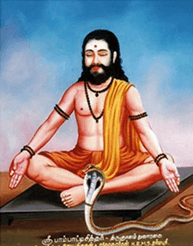THE LINE OF THE 19 SIDDHAS
Siddhas have attained the highest possible consciousness
and work to maintain balance in the universe.

The lineage of the 19th Siddhas has its origins in Tamil Nadu, South India.
Siddhas are among the highest enlightened masters in the world.
They all attained universal consciousness through intensive yogic and spiritual practices.
Their knowledge includes medicine, alchemy, astrology, yoga, tantra, meditation and the universal consciousness of God/ Source.
In short, they are omniscient.
You can’t fool them, because they immediately see the essence of all and behind the “curtains”.
The work of the Siddhas is primarily to keep the world and the universe in balance and to help people lead healthy and fulfilling lives.
All siddhas are associated with the god Shiva.
Either as his “apprentice” or even as Shiva himself, because they become ONE with God.
Time, space and matter are no limits for Siddhas
The abilities of the siddhas are divided into categories.
The most important of these lists the “ASTHAMA SIDDHIS” (eight siddhis):
“1.
To become as small as the atom within the atom.
(ANIMA).2. to grow huge, in unshakeable proportions.
(MAHIMA).3. to become as light as floating vapor.
(LAGHIMA).4. to become as heavy as the mountain.
(GARIMA).5. to go into other bodies.
(PRAPTI).6. to be in all things, all-pervading.
(PRAKAMYA).7. to be the Lord of all creation.
(ISATVAM).8. to be everywhere, omnipresent. (VASITVAM). “
– THIRUMANDIRAM 1780
In addition, 10 other siddhis are mentioned in the BHAGAVATA PURANA:
“1.
Being undisturbed by hunger, thirst and other physical desires.2. to hear distant things (they say they can hear the grass grow).
3. to see distant things.
4. moving the body to where the thoughts go (telepathy, astral wandering, bilocation).
5. to take any desired form.
6. to enter other bodies.
7. to die (leave the physical body) at a time they want.
8. to participate in, and witness the past time of the gods.
9. perfect fulfillment of one’s own destiny.
10. orders and instructions are unhindered.”
A SIDDHA is therefore someone who has mastered all these siddhis.
Siddha means “perfection”.
They have lived in every age and will probably always exist.
Their life expectancy is way above average.
They are said to live for hundreds, even thousands of years.
As alchemists and herbalists, they invented the most powerful remedies.
Ayurveda was also brought into being by the Siddhas.
The Siddhas know 4 stages of liberation (Mukti):
1 Salokya – live in God’s world.
2. samipya – to be close to God.
3. sarupya – taking the form of God.
4. sayujya – to be ONE with God.
There is a Tamil proverb “Sittan pokku, Sivan pokku.” It means a Siddha follows the path of Lord Shiva.
Siddhas are free beings and independent of any systems, dogmas, sects and religions.
They have reached a level where rules no longer apply and they themselves go beyond the sacred scriptures of the Vedas and Upanishads.
“… for seeking enlightenment in words is like expecting to feed a hungry man by looking at a menu.”(palanitemples.com/english/about_siddhas.htm)
Siddhas worship Nature as the Divine Mother, embody her aspects and have power over the 5 elements (earth, water, fire, air, ether).
They left behind manuscripts, most of which were written in a secret language.
You have to read between the lines to understand them.
Something that only a few can do.
Some of these sacred manuscripts and poems of the Siddhas can be found today in a palmleaf library in Tanjavur, Tamil Nadu.
SIDDHA PAMBATTI says: “Those who have attained true self-realization will not flaunt it and those who have not attained it will flaunt it…”
The desire for popularity is completely unknown to the Siddhas.
They would never do something just to show off or do something that violates the rules of nature.
Everything they are and do is in absolute harmony with the laws of nature.
THE 19 SIDDHAS:
1. AGASTYA
2. BHOGAR
3. PAMBATTI
4. AEGAPAI
5. KAMALAMUNI
6. KORAKKAR
7 RAMADEVAR
8TH THIRUMOOLAR
9TH VALMIKI
10. SUNDARANANDAR
11TH IDAIKADAR
12. ALUKAN
13. KALANGINADAR
14 CONGANAR
15 KARUVOORAR
16. DHANVANTHRI
17TH SITTAIMUNI
18 MACCHAMUNI
19. SRI LA SRI MAGA ANANDA SITTAR

